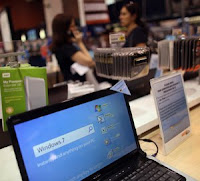Here's looking into all that's new in Windows 7.
File folders can now be organized into "libraries."
You can have a photo library, for instance, that gives you quick access to pictures in folders spread out over your hard drive, or even several hard drives. This is great because many applications don't automatically put files into Microsoft's My Documents and My Photos folders, and tend to deposit content in their own folders. The new arrangement also makes for easy backups.
Multitouch sensing
Windows 7 can sense if you use more than one finger on your touch pad or touch screen, allowing for neat tricks such as spreading your fingers to zoom into a picture, just like on the iPhone. This isn't revolutionary per se - computer manufacturers have bolted multitouch sensing on previous versions of Windows. But it does make it easier for them to include advanced touch capabilities, and many of them are planning to do so. That is what could really revolutionize how we use computers.
64-bit operating system
For a lot of users, the step up to Windows 7 will also mark a transition to a 64-bit operating system. That means computers will now be able to use a lot more Random Access Memory, or RAM, for better performance in demanding applications such as video editing. Vista and XP came in 64-bit versions in addition to the regular 32-bit versions, but the XP version was never popular, and the Vista version became mainstream only last year. But 64 bits will be standard on Windows 7, installed on nearly all new computers.
Faster search
Windows XP users have a lot more to gain by going to Windows 7. Vista introduced some great features, such as fast searches of the entire hard drive that of course are present in 7 as well. Windows 7 addresses Vista's problem of resource hungriness. The boot time was fast, and so was the time taken to come out of the hibernation mode. Reviewer Benny Har-Even in IT PRO found that "Windows 7 brings a more responsive and sprightly feel."
It also seems to work with the smaller and cheaper netbooks that’s fast getting popular. Reviewer Adrian Kingsley-Hughes writes in ZDNet, "Windows 7 works on netbooks, but if you push the system the same way as you push a desktop system then you might need to add more RAM. On top of that, remember that Windows 7 takes some 7.5 GB of disk space, so you need to factor this in. My advice would be not to bother upgrading an existing netbook unless you really feel you want a particular Windows 7 feature. Wait for Windows 7 netbooks to arrive on the scene as some of these will hopefully come with 2GB of RAM fitted."
Better desktop organization
For those who use a number of applications and files at the same time, there's a new facility that helps to reduce desktop clutter. You can now drag them and stack them in groups on the taskbar.
And what's more, if you hover the mouse over, say, the Windows Explorer stack, each window in it will appear horizontally as thumbnails, and you can click on the one you need to start using it. Right clicking on a stack gives a 'jump menu' that lets you see your most recent files. You can also 'pin' files that you use regularly on to a stack, so that they are always there on top of a stack.
Removing clutter with a shake
If you have a number of windows open and you want to focus on one and avoid the clutter around it, just take the mouse to that window's titlebar and shake it. Everything else disappears. Shake the same way again, and all others reappear.
Remote media streaming
This one wasn't there in the beta version but was available on the RC. It allows users to access all the files on their home computer remotely, somewhat like how Slingbox allows users to remotely access the TV channels they get on their home TV.
Windows XP mode
Users who like to keep their old stuff longer will like this. It allows you to run a XP application on Windows 7. But Preston Gralla of ComputerWorld who tested the feature says home users are not likely to have a great experience with it.
"Sharing files between the two environments (XP and 7) will be a challenge... (and) it's not designed for games," he says. However, he finds it a great tool for businesses that have already sunk money into XP applications. Microsoft says small businesses using, say, Tally accounting solutions on XP will be able to continue using those on Windows 7.
Less security irritants
Like Vista, Windows 7 will ask you twice if you really want to make changes to your settings or install programmes, for the sake of security. But Windows 7 does it less often, and the prompts can be turned off.
One big trouble with Vista was that each time a change was made to the system, a dialogue box would pop up asking you if you were ok with the change being made. It was designed as a security measure, to keep you aware of hackers trying to write on to your system. But it proved a huge annoyance for users installing new applications frequently. Windows 7 now allows you to set the level of information you desire.
Device compatibility
Microsoft's Nash says almost all devices will work with Windows 7. "The customer will not have to enqure whether a device he is buying (printer, fax machine, smart card reader, network controller, in fact, anything) will work with the OS," he says. The OS also identifies the device being installed and offers appropriate follow-on options.


























0 comments:
Post a Comment